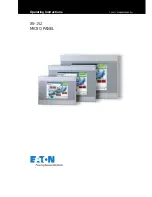
14
The assembled KLE can be used to secure preconfigured and self-designed
Carriage systems.
To do this, there are 4 mounting bores in the cover plate of the Carriage for
securing a support plate. Depending on the system sizes Carriage Plate
KLE 6 60x60 (0.0.609.25) and Carriage Plate KLE 8 80x80 (0.0.609.24) are
available as preconfigured support plates.
A calliper between the end of the profile and the marking on the tensioning
axle enables precise pre-tensioning on both sides of the Reverse Unit.
Tighten the Timing Belt by tightening the two screws alternately and evenly.
It is vital that the tightening is not uneven, i.e. that the tensioning axle is
not skew by > 0.05 mm!
The tensioning screws are secured (micro-encapsulated) to prevent them from
being adjusted or working themselves loose unintentionally.
You can tighten the Timing Belt using Reverse Unit KLE 6 60x60 or Reverse
Unit KLE 8 80x80.
Two Hexagon Socket Head Cap Screws DIN 912 are provided for this purpose
on the end of the Reverse Unit.
The first step when tightening the Timing Belt is to find the zero point at which
the untightened belt has no sag at all and pre-tensioning begins.
To do this, pull back the movable tensioning axle in the Reverse Unit and then
fix it in position using the screws.
A scale on the Reverse Unit can be used to adjust the tensioning axle travel
from this reference position.
Mounting bores prepared:
KLE 6 60x60 for M6
KLE 8 80x80 for M8
Tightening the Timing Belt:
Support system, Carriage Plate
Example KLE 8 80x80:
KLE 8 80x80 profile length 5m
=> Tensioning axle travel = 5 mm
Check:
KLE 8 80x80 profile length 5m
F
x
=
200 N
L
B
=
10 m
Δ L =
10 mm (based on simplified rule of thumb)
Where: F
Bpre
= 2,260 N > F
x
= 275 N
and: F
Bpre
= 2,260 N + 275 N < F
Bperm
= 4,500 N











































